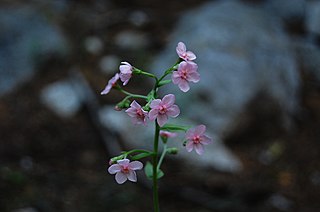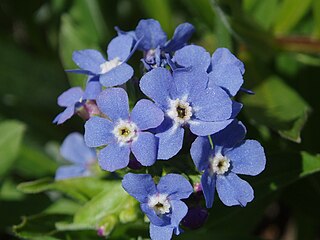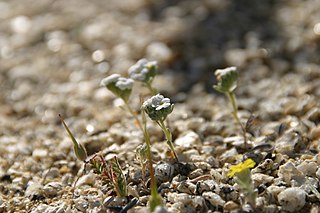
Hackelia (stickseeds) is a genus of plants in the borage family, Boraginaceae. It includes 54 species found in North America, western South America, temperate Eurasia, and Australia. 12 species are native to California.

Hackelia virginiana, a biennial plant, is commonly known as beggar's lice, sticktight or stickseed. However, the common names beggar's lice and stick-tight are also used for very different plants, such as Desmodium species that are also known as "tick-trefoil".
Hackelia bella is a species of flowering plant in the borage family known by the common name greater showy stickseed.

Hackelia californica is a species of flowering plant in the borage family known by the common name California stickseed.

Hackelia floribunda is a species of flowering plant in the borage family known by the common names large-flowered stickseed and manyflower stickseed.

Hackelia mundula is a species of flowering plant in the borage family known by the common name pink stickseed. It is native to the high mountains of California, especially the Sierra Nevada. Its range extends into Oregon. This is a lush, hairy perennial herb growing to maximum heights between 40 and 80 centimeters. It produces an array of erect stems with oval- or lance-shaped leaves most abundant around the bases, growing up to 22 centimeters long. The upper stems are mostly leafless and hold cyme inflorescences of flowers. Each petite flower has 5 rounded lobes which are light pink and age to light blue in color, each with a smaller petallike appendage at its base. The fruit is a small nutlet covered in thin, hairlike prickles.

Hackelia nervosa is a species of flowering plant in the borage family known by the common name Sierra stickseed. It is native to the mountains of California, especially the Sierra Nevada and its foothills, in areas with some moisture up to near treeline. Its range may extend into Nevada.

Hackelia velutina is a species of flowering plant in the borage family known by the common name velvet stickseed.

Senecio tamoides, also known as Canary creeper, false grapevine, and parlor ivy, is a climbing member of the genus Senecio of the family Asteraceae that is native to Southern Africa. It is used as an ornamental plant for its showy yellow, daisy-like flowers in late autumn through to winter.

Cirsium douglasii is a species of thistle known by the common names Douglas' thistle and California swamp thistle.
Hackelia amethystina is a species of flowering plant in the borage family known by the common name amethyst stickseed.
Hackelia brevicula is a species of flowering plant in the borage family known by the common name Poison Canyon stickseed.

Hackelia cusickii is a species of flowering plant in the borage family known by the common name Cusick's stickseed.
Hackelia setosa is a species of flowering plant in the borage family known by the common name bristly stickseed. It is native to the Klamath Mountains of northern California and southern Oregon, United States, and it is also known from Sierra Valley to the southeast of that range.

Hackelia venusta is a rare species of flowering plant in the borage family known by the common name showy stickseed, or lesser showy stickseed. It is endemic to Washington state in the United States, where it is known from only one canyon in Chelan County. There is only one small population with a global distribution of less than one hectare. The plant was federally listed as an endangered species of the United States in 2002.

Hackelia cronquistii is a species of flowering plant in the borage family known by the common name Cronquist's stickseed.

Andesanthus lepidotus, synonym Tibouchina lepidota, also known as alstonville, Andean princess flower, lasiandra, or glory bush, is a medium-sized ornamental tree or a large shrub native to northwestern South America that is cultivated for its masses of purple flowers from autumn right through to winter.

Eremocarya is a genus of flowering plants in the family Boraginaceae. There are about 63 species and its native range extends through western United States to northwestern Mexico. It is part of subtribe of Amsinckiinae.
Austrobryonia micrantha, commonly known as desert cucumber or mallee cucumber, is a species of flowering plant belonging to the family Cucurbitaceae, native to inland Australia.

Hackelia deflexa is a vascular flowering plant in the borage family known by the common names, northern stickseed, nodding stickseed, and American stickseed
















